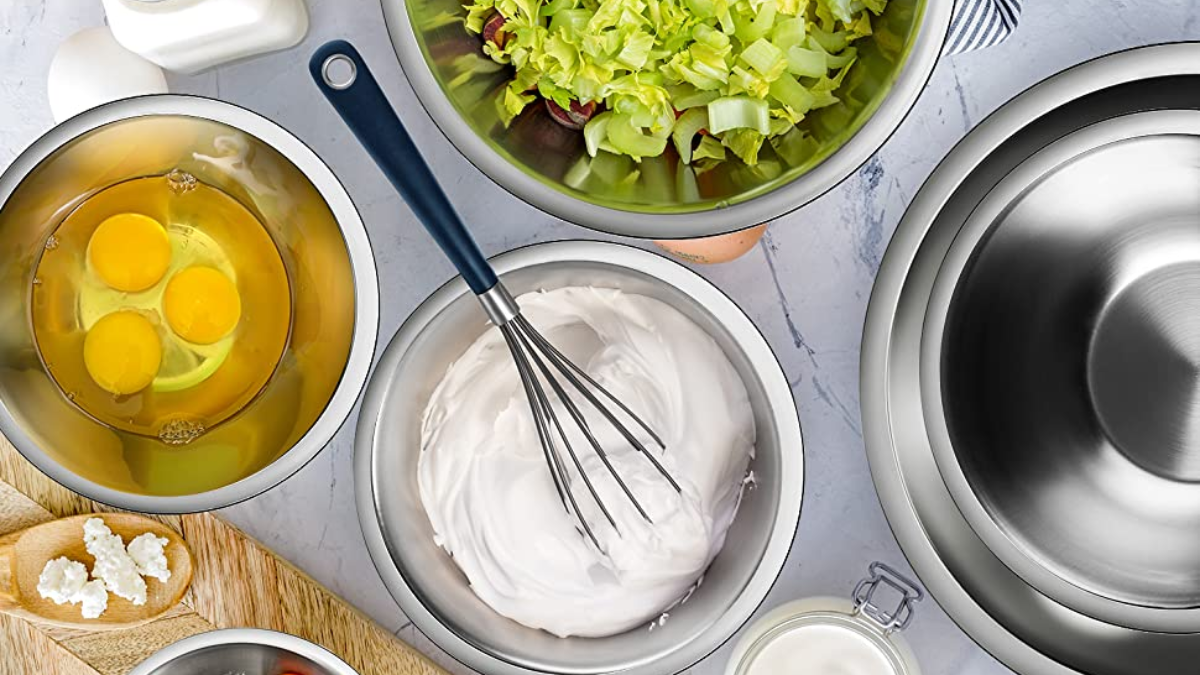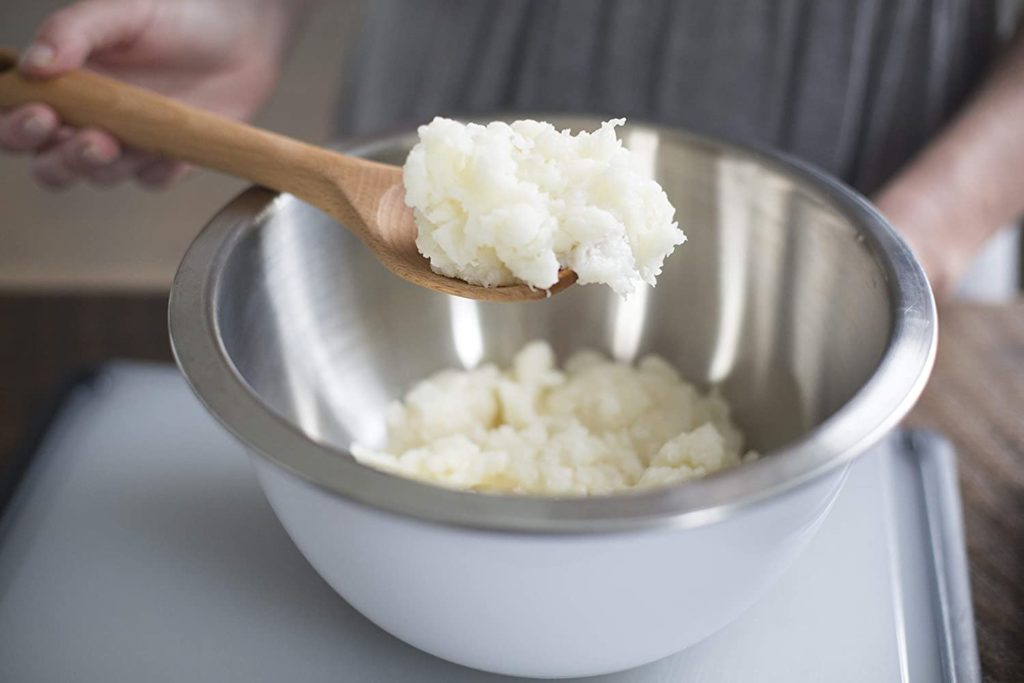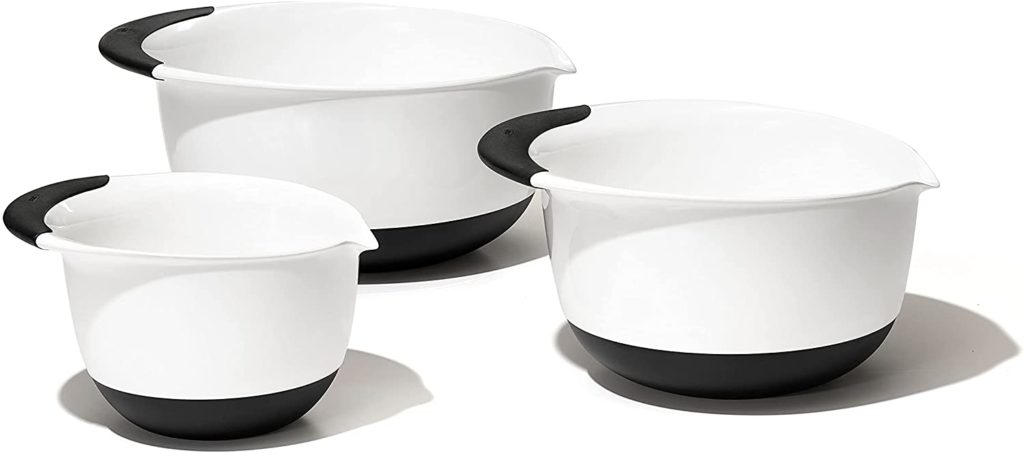Without a set of mixing bowls, no kitchen is complete. You’ll find yourself repeatedly reaching for your mixing bowls, whether for stirring ingredients, marinating foods for the grill, storing leftovers, organizing measured amounts of materials before starting a challenging task or even serving a salad or other meal. How can you decide which ones are ideal for you when there are so many options in terms of sizes, materials, and prices? It’s useful to have a variety of bowls in different sizes and shapes if your living space and financial situation allow it.
Whether you’re creating bread, salsa, or a salad, there are mixing bowls and sets with various benefits that will make your task easier. Some dishes are ideal for the microwave, while others allow you to rapidly transition from combining a marinade to melting chocolate in a bain-marie on the stove.
What are Exactly Mixing Bowls?
A mixing bowl is a deep bowl that is especially useful for combining components. These are available in various materials, including plastic, glass, ceramic, and stainless steel. Get mixing bowls that can be used with a handheld electric mixer and have high enough sides to prevent splatter if you decide to use that appliance instead of a standing mixer.
As it is frequently important to keep mixes of ingredients separate when baking, it is usual to have at least three mixing bowls of various sizes. Additionally, the produced dough can be kept in the mixing bowl straight in the refrigerator, so take into consideration basins with covers that can tolerate temperature changes effectively for such storage (if your bowls do not have lids, plastic wrap, or aluminum foil may be used to cover them).
Why is a Mixing Bowl Important?
Preparing bowls are useful for organizing, storing, working with dough, combining dry ingredients, and mixing salads. The kitchen requires a variety of bowls of various sizes. Mixing bowls come in handy for various tasks, including mixing bread and salad ingredients and wet and dry ingredients. It is advised that you have at least five mixing bowls in your set. Bowls are useful kitchen utensils that make it easier to handle and prepare meals.
Plastic is the popular alternative because of its strength and longevity with heavy usage and regular washing in the kitchen. They are available in various sizes and capacities and are constructed of various materials, including stainless steel.
Choosing the Best Mixing Bowl for Cooking
Here are some of the best mixing bowls for cooking:
OXO Good Grips 3-Piece Stainless-Steel Mixing Bowl Set
Features:
- 3-Piece Set includes 1.5-quart, 3-quart and 5-quart Stainless Steel Mixing Bowls
- 1.5-quart size ideal for whisking eggs or salad dressings, 3-quart size perfect for use with electric mixers, 5-quart size designed for doubling recipes, tossing salads and serving popcorn
- Stainless steel interiors won’t retain odors or colors, and white plastic exteriors shield hands from extreme heat.
- Non-skid bottoms stabilize Bowls while mixing, even when tilted
- Perfect for chilling and marinating
- Bowls nest for compact storage, dishwasher safe
OXO Good Grips 3- Piece Mixing Bowl Set
Features:
- Set includes: 1.5, 3.0 and 5.0 qt sizes
- Wide grip and spout for easy pouring
- A non-slip bottom stabilizes the bowl while mixing
- Soft, comfortable, non-slip handle
- Bowls nest for compact storage
- 1-1/2-quart size perfect for whisking eggs or salad dressings, 3-quart size designed for use with electric mixers, 5-quart size ideal for tossing salads or serving popcorn
Stainless Steel Mixing Bowls
Features:
- A range of 6 Sizes—¾, 1.5, 3, 4, 5, and 8 quart—metal mixing bowls add versatility and functionality to your kitchen. For all-purpose kitchen workhorses from prepping, mixing, stirring, to kneading dough like a pro
- Features an attractive mirror finish for an elegant look enhancing your kitchen. These metal bowls are easy to clean as well as odor, stain and taste resistant
- Our lightweight stainless-steel bowls—ideal for everyday tasks—are made from the freezer– and dishwasher-safe, durable, shatterproof materials to last a lifetime
- The wide-rolled rims allow drip-free pouring and a solid grip. Flat bases provide balance and stability for tossing salads, whipping creams etc. Capacity marked outside bowls for easy identification
- These salad bowls—or serving bowls—seamlessly nest together and offer space-efficient storage that helps de-clutter kitchen cupboards. Mixing bowls for kitchen mixing bowl sets for kitchen
Nordic Ware Prep & Serve Mixing Bowl Set
Features:
- Set includes 2 quarts, 3.5 quart, 5 quart and 7-quart heavy-duty bowls
- Great for mixing, prepping, and storing as well as serving food at picnics and potlucks
- Top rack dishwasher-safe with slip-free silicone bottoms
- BPA-free and Melamine Free Plastic
- Made in the USA
Cuisinart CTG-00-SMB Stainless Steel Mixing Bowls with Lids, 3 Piece
Features:
- 1-1/2-Quart, 3-Quart and 5-Quart sized bowls
- High-quality stainless steel
- Dishwasher safe
- Freezer safe
- Refrigerator safe
What to Look for in a Set of Mixing Bowls?
At first, glance, buying mixing bowls may appear simple. Nevertheless, these are useful tools; if you want them to simplify your cooking, they must match your preferences and requirements. So, before we discuss the best mixing bowls, Here is a list of considerations to make:
Volume
The selection of bowl sizes at your disposal expands as the set gets bigger. Small sets often start with a bowl around 1 quart in size and gradually rise to a 5-quart bowl. The bowl sizes in larger sets range from smaller to larger, as well as increments in between.
For swiftly melting butter in the microwave and chopping up ingredients for your recipes, choose the smallest-capacity bowls. Most of your mixing will be done in medium-sized bowls, but larger bowls are useful for combining components or when more room is required to prevent spills.
Bowl Shape
What you’re combining will determine which shape of the mixing bowl is best, according to various perspectives. Finding what you like best may require some experimentation, but here are some suggestions to get you going.
- Shorter and wide: This is the style preferred by most savory-focused cooks because the shallower depth of the bowl makes it easier to reach in and mix or whip whatever you’re working on. The standard ratio for a bowl of this shape is: Height is roughly half the size of the diameter of the bowl. So if you have a 10-inch wide bowl, the sides should be about 5-inch tall (within an inch or so). The shape of this style bowl also lends itself to easily tossing salads, salting french fries, and adding sauce to wings.
- Taller sides: Bowls almost as tall as they are wide also have a place in the kitchen. Most pastry cooks reach for these bowls to mix cookie doughs and cake batters without fear of spilling whatever might splash up. Convenient for use with longer hand tools, immersion blenders, and hand mixers, taller-sided bowls mimic the deeper bowls on stand mixers that accommodate a substantial amount of mixing work.
- Flat bottom: The purpose of flat-bottomed bowls is to provide stability in the mixing process. If you’re mixing something that requires both hands or blending a liquid you’d rather not risk toppling over, a flat-bottomed bowl is a little more dependable than a rounded-bottom bowl.
- Round bottom: For those looking for the flexibility to smoothly flick or rotate a bowl while mixing, the rounded bottom bowl is the way to go. The continuous curve of the bowl also makes whisking and scraping the bowl a seamless movement. A nicely rounded bowl can also be used as a mold for recipes set or baked and flipped out for a domed presentation.
Appliance Compatibility
- Dishwasher Safe: The convenience of rinsing your mixing bowls and then washing them in the dishwasher is a luxury that can’t be overlooked, especially when removing oily dressings that coat the bowl or sanitizing bowls that have held raw meats. Most bowls, even the most economically priced ones, are dishwasher safe and will be labeled accordingly.
- Microwave Safe: Perhaps the most important consideration for some cooks is whether or not the bowls are microwave safe. College students and cooks with limited cooking space may rely on the microwave to take on some, if not all, of the heating work. Bowls should be clearly labeled as microwave safe. Most plastic, glass, and ceramic bowls fit into this category but always double-check before purchasing.
-
Stovetop: Cooks in professional kitchens have been known to heat butter or sauce in a stainless steel bowl directly on the open flame of a stovetop if they’re in a hurry. While this cooking method happens far less often at home, having a bowl that can be used over a double boiler or flashed over an open flame can be very useful.
Stainless steel bowls will be able to handle the heat of the stovetop without an issue. Some glass and ceramic bowls can also be used on top of a double boiler, but they do not conduct heat as quickly or efficiently as metal. They may continue to cook your ingredients after removing them from the heat because they retain heat for longer. -
Oven: Generally speaking, if a bowl can be used on the stovetop, it can probably be used in the oven. As always, check the manufacturer’s recommendation before baking with your mixing bowl, and make sure that it is placed on a stable surface (such as a sheet tray) for even baking.
Colors
Mixing bowls are available in just about any color you want, from neutral monotones to rainbow palettes to coordinating sets so you can match your existing kitchen equipment. Vibrant colors are available mostly in plastic or ceramic options, but you can occasionally find colored glass options.
Price
The most useful kitchen tools won’t set you back a fortune. A three to the six-piece set of mixing bowls will typically cost between $25 and $35.
Bowls made of plastic and stainless steel that are reasonably priced will function just as well for you as more expensive bowls. The differences are in the durability of the bowls, extra components (such as lids and graters), and design elements that, depending on whether you plan to serve or exhibit the bowls, may or may not be important to you.
Warranties
Manufacturer warranties on most branded mixing bowls can last anywhere from two years to a lifetime. These guarantees cover any flaws that may exist right out of the box and possible breakage while using your bowl as intended (like a Pyrex bowl breaking while in the oven). Regular wear and tear are often not covered by warranties. If there is any indication that you used the bowl that the manufacturer didn’t intend, your guarantee will probably be voided.
Are the Sizes of the Bowls Practical?
A set with six separate bowls could seem alluring, but what use is it if half of them can only store a modest amount of spices? Instead, when shopping for mixing bowls, go for a variety that includes at least one small (1-112 quart) prep bowl and two bigger basins in the 3- to the 8-quart range. This will give you enough space to fold and toss without fear of spilling and will allow you to do so confidently.
Conclusion
In most cases, mixing bowls are not the first thing that springs to mind when considering kitchen necessities. Each of these mixing bowls excels in a different area. Choose a glass or ceramic mixing bowl if you want a multifunctional set that you can use as a mixing bowl, put in the oven, clean in the dishwasher, and use as a serving bowl on a fine dining table. If you prefer a more robust and user-friendly bowl set, have a look at the plastic and stainless steel options. In either case, having a multipurpose set will make cooking much simpler.







